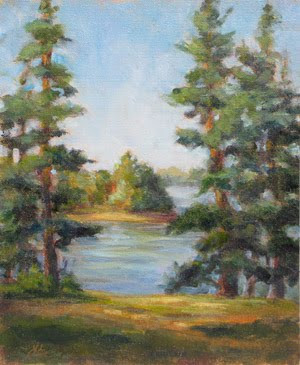 "An Inviting Place"
"An Inviting Place"© Nancy Laliberte
10" x 8" acrylic on canvas panel
plein air study
This is another painting from my recent plein air workshop with artist Ken DeWaard. One of the things Ken talked about in the workshop was, "What's your story? What do you want to say (with your painting)?" With this piece, I thought the sandy shore in the midground looked like an inviting place. I used the foreground grass and pine trees as a way to lead the eye in by keeping the values a bit darker (which they were); and exaggerated the grayness of the background to create a greater sense of distance (which it wasn't so much). With plein air painting you learn to push and pull values and color to help "tell your story." Painting exactly what you see, may not be the best way to tell your story. I may add some people and a canoe to the beach. They weren't there at the time, but that is the beauty of artistic license.
More tips and techniques learned from Ken's workshop.
• Have several panels prepared with a couple of different color washes. Lots of green? Try a warmer, reddish panel. (I like transparent red oxide.) Lots of sky or winter? Try a ochre or transparent yellow oxide wash. Experiment! (shown above)
• Starting: Draw a line around the panel about 1/2 inch in or so as a visual reminder for composition and framing. (shown above)
• Look for verticals, horizontals and diagonals in your scene. Make thumbnail sketches of the basic SHAPES (not objects!). (shown above)
• Step back.
• Color and value notes: Lay in your lightest light, darkest dark, and brightest color.
• Step back.
• Squint for value, look at the edges of shapes for color.
• Step back.
• Mass in local color.
• Step back.
• Go back and define the color shapes with cools and warms. Keep values close to original, then go into temperature changes. Build up the subtleties.
• Step back.
• Add details to the focal point. That area should have the most contrast and detail.
• Step back. I think you get the idea on this one : )
• Keep in mind, your darkest darks are not shadows, they are underneath objects. With sunlit objects, the dark color under them will be warmer because the ground is warmer, or sunlit around the object.
• Be saturated in your color, it is easier to gray down color than it is to jack it up.
• If you paint a warm color note, follow it with a cool color note, vice versa. For some great examples of this, see Ken's work, Dan Gerhartz's and Scott Burdick's to name few.
This is the second time I have studied with Ken. Not only is he an incredible artist, he is also a great teacher and person. I highly recommend his workshops.


3 comments:
Thank you for sharing great painting tips!
Lovely painting. I think I've been there.
I found your blog through Artist Helping Artist blog...very nice work, especially your plein air paintings.
Thanks for sharing what you learned in Ken DeWaard's workshop. I have a plein air workshop coming up soon so this information will be helpful.
Post a Comment